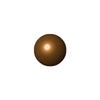+ Open data
Open data
- Basic information
Basic information
| Entry | Database: PDB / ID: 6kng | ||||||
|---|---|---|---|---|---|---|---|
| Title | CryoEM map and model of Nitrite Reductase at pH 8.1 | ||||||
 Components Components | Copper-containing nitrite reductase | ||||||
 Keywords Keywords | OXIDOREDUCTASE / Cu containing nitrite reductase | ||||||
| Function / homology |  Function and homology information Function and homology informationdenitrification pathway / nitrite reductase (NO-forming) / nitrite reductase (NO-forming) activity / nitrate assimilation / periplasmic space / copper ion binding Similarity search - Function | ||||||
| Biological species |  Achromobacter cycloclastes (bacteria) Achromobacter cycloclastes (bacteria) | ||||||
| Method | ELECTRON MICROSCOPY / single particle reconstruction / cryo EM / Resolution: 2.85 Å | ||||||
 Authors Authors | Adachi, N. / Yamaguchi, T. / Moriya, T. / Kawasaki, M. / Koiwai, K. / Shinoda, A. / Yamada, Y. / Yumoto, F. / Kohzuma, T. / Senda, T. | ||||||
| Funding support |  Japan, 1items Japan, 1items
| ||||||
 Citation Citation |  Journal: J Struct Biol / Year: 2021 Journal: J Struct Biol / Year: 2021Title: 2.85 and 2.99 Å resolution structures of 110 kDa nitrite reductase determined by 200 kV cryogenic electron microscopy. Authors: Naruhiko Adachi / Takahide Yamaguchi / Toshio Moriya / Masato Kawasaki / Kotaro Koiwai / Akira Shinoda / Yusuke Yamada / Fumiaki Yumoto / Takamitsu Kohzuma / Toshiya Senda /  Abstract: Cu-containing nitrite reductases (NiRs) are 110 kDa enzymes that play central roles in denitrification. Although the NiRs have been well studied, with over 100 Protein Data Bank entries, such issues ...Cu-containing nitrite reductases (NiRs) are 110 kDa enzymes that play central roles in denitrification. Although the NiRs have been well studied, with over 100 Protein Data Bank entries, such issues as crystal packing, photoreduction, and lack of high pH cases have impeded structural analysis of their catalytic mechanisms. Here we show the cryogenic electron microscopy (cryo-EM) structures of Achromobacter cycloclastes NiR (AcNiR) at pH 6.2 and 8.1. The optimization of 3D-reconstruction parameters achieved 2.99 and 2.85 Å resolution. Comprehensive comparisons with cryo-EM and 56 AcNiR crystal structures suggested crystallographic artifacts in residues 185-215 and His255' due to packing and photoreduction, respectively. We used a newly developed map comparison method to detect structural change around the type 2 Cu site. While the theoretical estimation of coordinate errors of cryo-EM structures remains difficult, combined analysis using X-ray and cryo-EM structures will allow deeper insight into the local structural changes of proteins. | ||||||
| History |
|
- Structure visualization
Structure visualization
| Movie |
 Movie viewer Movie viewer |
|---|---|
| Structure viewer | Molecule:  Molmil Molmil Jmol/JSmol Jmol/JSmol |
- Downloads & links
Downloads & links
- Download
Download
| PDBx/mmCIF format |  6kng.cif.gz 6kng.cif.gz | 176.2 KB | Display |  PDBx/mmCIF format PDBx/mmCIF format |
|---|---|---|---|---|
| PDB format |  pdb6kng.ent.gz pdb6kng.ent.gz | 140.7 KB | Display |  PDB format PDB format |
| PDBx/mmJSON format |  6kng.json.gz 6kng.json.gz | Tree view |  PDBx/mmJSON format PDBx/mmJSON format | |
| Others |  Other downloads Other downloads |
-Validation report
| Summary document |  6kng_validation.pdf.gz 6kng_validation.pdf.gz | 881.2 KB | Display |  wwPDB validaton report wwPDB validaton report |
|---|---|---|---|---|
| Full document |  6kng_full_validation.pdf.gz 6kng_full_validation.pdf.gz | 887.9 KB | Display | |
| Data in XML |  6kng_validation.xml.gz 6kng_validation.xml.gz | 33 KB | Display | |
| Data in CIF |  6kng_validation.cif.gz 6kng_validation.cif.gz | 46.2 KB | Display | |
| Arichive directory |  https://data.pdbj.org/pub/pdb/validation_reports/kn/6kng https://data.pdbj.org/pub/pdb/validation_reports/kn/6kng ftp://data.pdbj.org/pub/pdb/validation_reports/kn/6kng ftp://data.pdbj.org/pub/pdb/validation_reports/kn/6kng | HTTPS FTP |
-Related structure data
| Related structure data |  0731MC  0730C  6knfC M: map data used to model this data C: citing same article ( |
|---|---|
| Similar structure data | |
| EM raw data |  EMPIAR-10581 (Title: CryoEM map and model of Nitrite Reductase at pH 8.1 / Data size: 1.0 TB EMPIAR-10581 (Title: CryoEM map and model of Nitrite Reductase at pH 8.1 / Data size: 1.0 TBData #1: CryoEM map and model of Nitrite Reductase at pH 8.1 [micrographs - multiframe]) |
- Links
Links
- Assembly
Assembly
| Deposited unit | 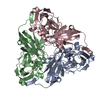
|
|---|---|
| 1 |
|
- Components
Components
| #1: Protein | Mass: 36621.332 Da / Num. of mol.: 3 / Source method: isolated from a natural source / Source: (natural)  Achromobacter cycloclastes (bacteria) / References: UniProt: P25006, nitrite reductase (NO-forming) Achromobacter cycloclastes (bacteria) / References: UniProt: P25006, nitrite reductase (NO-forming)#2: Chemical | ChemComp-CU / Has ligand of interest | Y | |
|---|
-Experimental details
-Experiment
| Experiment | Method: ELECTRON MICROSCOPY |
|---|---|
| EM experiment | Aggregation state: PARTICLE / 3D reconstruction method: single particle reconstruction |
- Sample preparation
Sample preparation
| Component | Name: Nitrite reductase / Type: ORGANELLE OR CELLULAR COMPONENT / Entity ID: #1 / Source: NATURAL |
|---|---|
| Molecular weight | Value: 0.11 MDa / Experimental value: NO |
| Source (natural) | Organism:  Achromobacter cycloclastes (bacteria) Achromobacter cycloclastes (bacteria) |
| Buffer solution | pH: 8.1 |
| Buffer component | Conc.: 100 mM / Name: pottasium phosphate |
| Specimen | Conc.: 1.1 mg/ml / Embedding applied: NO / Shadowing applied: NO / Staining applied: NO / Vitrification applied: YES / Details: This sample was mono-disperse. |
| Specimen support | Details: The grid was washed by acetone prior to use. / Grid material: COPPER / Grid mesh size: 300 divisions/in. / Grid type: Quantifoil R1.2/1.3 |
| Vitrification | Instrument: FEI VITROBOT MARK IV / Cryogen name: ETHANE / Humidity: 100 % / Chamber temperature: 291 K / Details: Blotting time was 15 seconds. |
- Electron microscopy imaging
Electron microscopy imaging
| Experimental equipment |  Model: Talos Arctica / Image courtesy: FEI Company |
|---|---|
| Microscopy | Model: FEI TALOS ARCTICA |
| Electron gun | Electron source:  FIELD EMISSION GUN / Accelerating voltage: 200 kV / Illumination mode: FLOOD BEAM FIELD EMISSION GUN / Accelerating voltage: 200 kV / Illumination mode: FLOOD BEAM |
| Electron lens | Mode: BRIGHT FIELD / Nominal magnification: 120000 X / Nominal defocus max: 3000 nm / Nominal defocus min: 1000 nm / Cs: 2.7 mm / C2 aperture diameter: 50 µm |
| Specimen holder | Cryogen: NITROGEN |
| Image recording | Average exposure time: 56.37 sec. / Electron dose: 50 e/Å2 / Detector mode: COUNTING / Film or detector model: FEI FALCON III (4k x 4k) / Num. of grids imaged: 1 / Num. of real images: 694 |
- Processing
Processing
| EM software |
| ||||||||||||||||||||||||||||
|---|---|---|---|---|---|---|---|---|---|---|---|---|---|---|---|---|---|---|---|---|---|---|---|---|---|---|---|---|---|
| CTF correction | Type: PHASE FLIPPING AND AMPLITUDE CORRECTION | ||||||||||||||||||||||||||||
| Symmetry | Point symmetry: C3 (3 fold cyclic) | ||||||||||||||||||||||||||||
| 3D reconstruction | Resolution: 2.85 Å / Resolution method: FSC 0.143 CUT-OFF / Num. of particles: 89513 / Symmetry type: POINT |
 Movie
Movie Controller
Controller



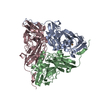
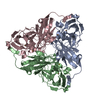

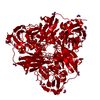

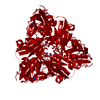
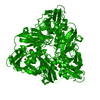


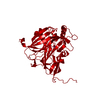
 PDBj
PDBj

